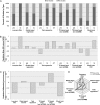Underconnected, but how? A survey of functional connectivity MRI studies in autism spectrum disorders
- PMID: 21378114
- PMCID: PMC3169656
- DOI: 10.1093/cercor/bhq296
Underconnected, but how? A survey of functional connectivity MRI studies in autism spectrum disorders
Abstract
Growing consensus suggests that autism spectrum disorders (ASD) are associated with atypical brain networks, thus shifting the focus to the study of connectivity. Many functional connectivity studies have reported underconnectivity in ASD, but results in others have been divergent. We conducted a survey of 32 functional connectivity magnetic resonance imaging studies of ASD for numerous methodological variables to distinguish studies supporting general underconnectivity (GU) from those not consistent with this hypothesis (NGU). Distinguishing patterns were apparent for several data analysis choices. The study types differed significantly with respect to low-pass filtering, task regression, and whole-brain field of view. GU studies were more likely to examine task-driven time series in regions of interest, without the use of low-pass filtering. Conversely, NGU studies mostly applied task regression (for removal of activation effects) and low-pass filtering, testing for correlations across the whole brain. Results thus suggest that underconnectivity findings may be contingent on specific methodological choices. Whereas underconnectivity reflects reduced efficiency of within-network communication in ASD, diffusely increased functional connectivity can be attributed to impaired experience-driven mechanisms (e.g., synaptic pruning). Both GU and NGU findings reflect important aspects of network dysfunction associated with sociocommunicative, cognitive, and sensorimotor impairments in ASD.
Figures

References
-
- Alexander AL, Lee JE, Lazar M, Boudos R, Dubray MB, Oakes TR, Miller JN, Lu J, Jeong EK, McMahon WM, et al. Diffusion tensor imaging of the corpus callosum in Autism. Neuroimage. 2007;34:61–73. - PubMed
-
- American Psychiatric Association. Diagnostic and Statistical Manual of Mental Disorders-IV-TR. Washington, DC: American Psychiatric Association; 2000.
-
- Auer DP. Spontaneous low-frequency blood oxygenation level-dependent fluctuations and functional connectivity analysis of the ‘resting’ brain. Magn Reson Imaging. 2008;26:1055–1064. - PubMed
Publication types
MeSH terms
Grants and funding
LinkOut - more resources
Full Text Sources
Medical

